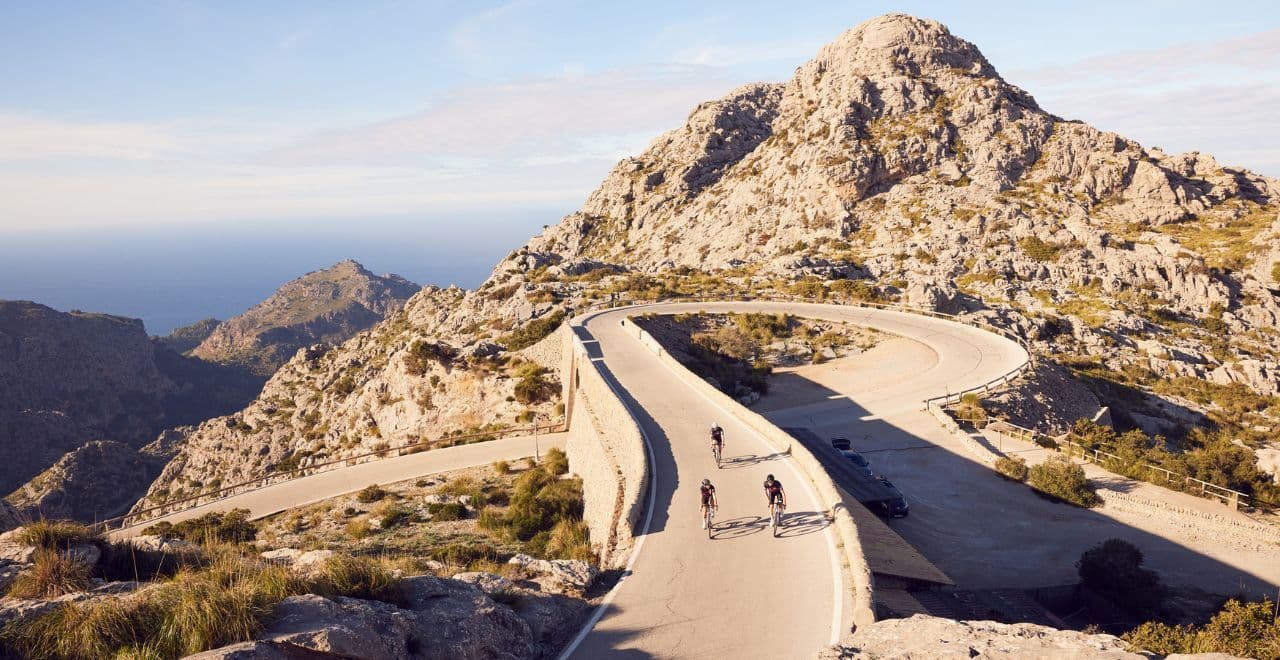

Sa Calobra climb in Mallorca – The Ultimate Cyclist’s guide
Sa Calobra
The Sa Calobra climb in Mallorca is arguably the toughest cycling climb on the island. It's revered by those who have cycled in Mallorca for its incredible views, hairpin turns and that it leads to nowhere. Cycle down it? Then you have to cycle back up!
From the tie knot just below the Coll dels Reis sign, to the cafe at the bottom, Sa Calobra weaves its way through rockface, across the limestone mountain and down into the sparkling Mediterranean below. Sa Calobra is no Alpine climb - its just 9.5k at 7% - but it's the home of the KOM on the island, with cyclists coming from across the world to test themselves on this climb. Made famous by British Cycling and their successes at London 2012, Team Sky and Bradley Wiggins made Sa Calobra their home, en route to Wiggins' Tour de France victory, as well as his victories at the Olympics.
The current KOM was smashed by Tom Pidcock in December 2022 with an incredible time of 22.46, averaging just shy of 25kph from the port to the top!
Make An Enquiry
We are the cycling holiday experts.
Whether you're a keen road cyclist, enjoy riding an e-bike or hybrid bike, or want to get your family more active, we have the perfect cycling holiday for you.
The Best Bits of Sa Calobra
One of the best parts of the ride is actually before you hit the climb. If you're riding from Port Pollensa in the north, you will come up past the aqueduct, a stunning row of 3 arches that lets you know that you're just a couple of kilometers from Sa Calobra.
Turn right and stop for an orange juice at the famous OJ Shack, or descend to the bottom of the short climb up to the the summit of the Coll dels Reis. From here, you will descend all the way to the bottom of the climb.
The most famous view of Sa Calobra is the tie knot which you pass just after you head over the top of the Coll dels Reis. The tie knot is an engineering feat of twisted asphalt which loops over itself and once you are underneath it, your real descent of Sa Calobra begins.
Sa Calobra is known for its epic views and you will find these at every corner. From the first view of the famous 270° loop of the tie knot, to the the endless hairpins snaking down to the water's edge, the vistas on offer as you descend Sa Calobra are breathaking.
Make An Enquiry
We are the cycling holiday experts.
Whether you're a keen road cyclist, enjoy riding an e-bike or hybrid bike, or want to get your family more active, we have the perfect cycling holiday for you.
The Ride
Getting to Sa Calobra
Before you even think about climbing Sa Calobra, you're in for a large amount of climbing through the Tramuntana to even get to it.
If you come from the north, and start out in Alcudia or Pollensa, you will ride the Coll de Sa Batalla, a great climb in itself at 8 kilometres averaging 5% or the Coll de Femenia, a 7.5km climb averaging 5.5%. If you come from, Soller, you're access will be via the Monnaber tunnel and the epic Puig Major climb (14 kilometres at 6%). Expect a big day in the saddle whatever Mallorca cycling route you choose to deliver you to Sa Calobra.
The Descent
What goes up must go down? Yes, but in this case, what goes down, must go up, unless you're planning to catch a boat from the Port of Calobra.
The descent begins as you ride through the split open rock which allows the road to pass through. You will see the Coll dels Reis signpost on your right and from here, it’s a 9.5km snaking descent down to the port. Take it easy on the descent, especially during the busy summer months as the road is tight with hairpins galore and plenty of cyclists and other traffic coming up from the bottom. We recommend riding as early as you can as the later you leave it, the more chance you will have of encountering a coach which can completely spoil the ride.
The First 5K
The start of the ride if you're on Strava is the sign to the right of the car park not the port! So if you're going for the KOM (!!) don't waste your energy until you hit the signpost.
Before you really get going on the climb, you will hit the famous section of road where the vertical limestone walls enclose the road. be really careful here as the road dips quite dramatically on the descent here and so oncoming cars or cyclists will struggle to see you coming up from the brow of the ramp.
The first section of the ride is pretty easy and there are virtually no hairpins and the riding is quite sheltered as you will be surrounded by trees.
The Hairpins
The hairpins kick in at around 6km and it's at this point that the road becomes very exposed. You will ride hairpin after hairpin as Sa Calobra unleashes a rapid number of snaking twists and turns traversing the limestone rock.
This part of the climb is where you will have seen the iconic aerial photos such as the one below which show just how spectacular the road is. The scenery changes constantly and the calm of the waters below sea provides a breathtaking backdrop.
The Final Ascent
The last 3 kilometres are the toughest with hairpins coming thick and fast.
The gradient increases and you will be able to see iconic- Nus the Sa Corbata (the “Tie knot”) come into view. Make your way around the 270 degree turn and then gun it to the top of the climb, 500m above you where the brown Coll dels Reis signpost stands.
Key statistics
Length: 9.5 kilometres.
Average Gradient: 7%.
Toughest Gradient: 12%.
Whilst the climb is not a toughie in comparison to the high Alps or the Pyrenees, it's a shortish burst with a gradient that rarely relents. Most pros will do this in under 30 minutes and a good club rider can ride it between 30 and 45 minutes. If you're not a particularly good climber, you will be in for a solid hour of climbing.
When to Ride Sa Calobra
The climb is open all year round and we have customers riding it from mid summer to during the Christmas holidays. Peak season is obviously the cycling seasons of Spring and Autumn, where Sa Calobra can be very busy with cyclists.
In the height of the summer, it's also busy but usually with coaches and tour groups, so it's best avoided then unless you go first thing. The earlier or later in the season you go, the quieter it will be. Many pro teams will head out there right at the start of the new year too when the roads are completely quiet, the sun is out but weak, and the air crisp and perfect for ascending.
Sa Calobra Weather
You need to check the weather before you think about climbing Sa Calobra as it's going to take you some time to get there and back. The top of Sa Calobra is completely exposed and so you want to be summiting as early as possible.
Riding in the Spring and Autumn months are ideal if you want to tackle Sa Calobra. The air is usually quite cool and the sun will provide some warmth on what is a long and fast descent. Make sure you have plenty of water before you set off because if the cafe at the bottom has no water or is closed, there's nowhere else to refuel until you're at the top, and even then the OJ Shack is closed in the off season.
Climbing Sa Calobra on a Mallorca Cycling Route
Mallorca is home to some of the most epic cycling in Europe. If you're heading out into the Tramuntana mountains, these are our favourite routes which pass by the aqueduct, allowing you to drop down to the port to test yourself against this climb.
Climbs & Cols
This route starts in the Tramuntana and rakes in some of our favourite climbs including the Coll de Soller, Puig Major and the lesser known climbs of the Coll d'Orient and the Coll d'Honor. You can add Sa Calobra to the route easily by turning left just before the aqueduct. Read about it here.
Route Around the Tramuntana
Our favourite route is one that takes in all of the best climbs. You can read about it here and it takes in the Coll d'Orient, the Coll d'Honor, the Coll de Soller, Puig Major and then for good measure, Sa Calobra. 134km with 2,500m of climbing in an epic day in the saddle.
The Epic Journey
The toughest route is surely the epic route from Andratx to Port Pollensa, which traverses the entire Tramuntana mountain range. We will take you from port Pollensa to Andratx at 8am, and then you can spend the day riding back, across jagged limestone cliffs and ascending and descending this epic route. The route is 120km with 2,700m of climbing. It's not for the feint hearted and if you want to add to those statistics, turn left just after you pass Gorg Blau and head down the climb.
Cafe Stops
At the bottom of the climb in the port, you’ll also find a restaurant which has a beautiful view over the water. It's mega expensive so unless you're ok with a ridiculous priced meal, stick to a coffee or a soft drink there!
There are no other places to refuel except a small cafe located on the tie knot and that only opens in peak summer. Make sure you have plenty of water and food for your climb, at any point in the season.
Once you've climbed out of Sa Calobra, the small Cafe Escorca is hidden just beyond the aqueduct.
Top Tips for Cycling Sa Calobra
Traffic
Let's get this out of the way first, Sa Calobra is not going to be an idyllic empty climb if you ride at the wring time. The best way to avoid traffic is to go early or late in the season or if you are there in peak season, to be ready to ride the climb by no later than 9am.
Alternatively, if you head down there very late in the afternoon/early evening in the summer, when there is still plenty of light, most of the tourists will have gone. Whenever you ride, watch out for oncoming traffic both 4 wheels and 2!
Route planning
Make sure you have planned how you're going to get to Sa Calobra and back. You can't access the climb without a lot of riding before and after so make sure you are well prepared with where you are heading.
Prepare for both the ascent and the descent. Even in warm weather, the descent can be cold and you will can stiff and achy as you grip on to your brakes on each hairpin. Make sure you have a windproof jacket or arm warmers. On the ascent, you will be completely exposed for the last 5km so make sure you have plenty of suncream and water.
Fill up your water bottles at the bottom!
Speed
We are all for blasting it up out of the port and going as hard and fast as possible but however good a cyclist you are, take it easy on the descents.
Cars need a wide berth and the road narrows at Sa Brexta meaning oncoming traffic just can't see you. Be super careful and hover over the brakes at the bottom of the climb.
Where to Stay
We recommend staying in Port de Pollensa, Alcudia or Soller when climbing the Mallorcan mountains and Sa Calobra. Each of them provides access to the mountains and each has its own charm and appeal.
Mallorca Cycling Routes
For more information about other exciting cycling experiences, visit our Mallorca cycling holidays page.


